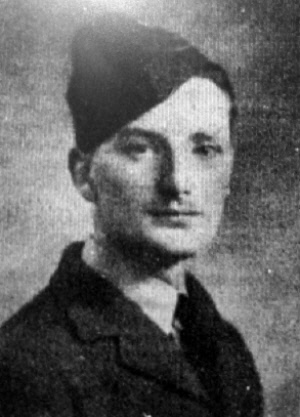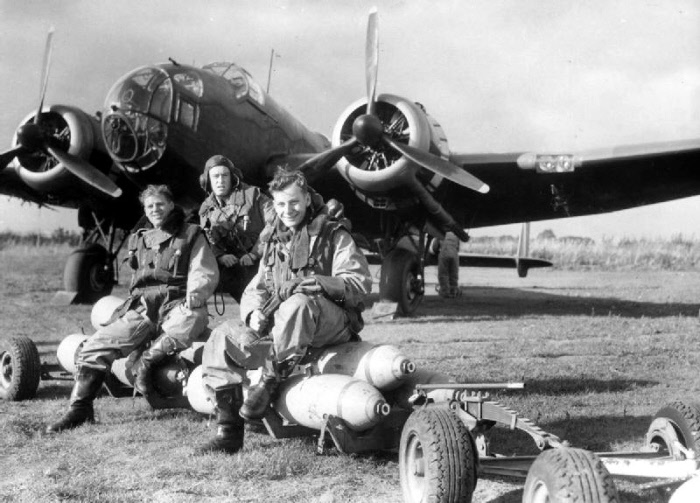
Kenneth Anthony Sayer was born in Ossett in 1919, the son of Midland Bank Manager, Hugh A. Sayer and his wife Clarissa (nee Palmer) who had married in Leeds in the summer of 1914. Kenneth had an elder brother John Sayer, born in 1915 and a younger brother Gerald Sayer, born in 1923, both in Ossett.
In early 1940, Sergeant Kenneth Sayer was awarded the Distinguished Flying Medal and the “Ossett Observer”1 had this report:
“The Distinguished Flying Medal has been awarded to Kenneth Anthony Sayer, son of Mr. H.A. Sayer, manager of the Ossett Branch of the Midland Bank. Born 21 years ago, he was educated at Southdale School, Wakefield Grammar School and Graham Sea Training School, Scarborough. In 1935, he joined the Asiatic Steam Navigation Co., Calcutta, as an apprentice, and left the following year on account of ill health. In 1937, he entered the service of the Elder Dempster Lines Ltd., Liverpool in the West African trade. Later he was employed by Mr. S. Briggs, solicitor and official receiver, Wakefield, but left after three months (February 1938) to join the RAF as a wireless operator.
He was trained at Cardington generally and Cranwell for wireless purposes. Since November 1938, when he was posted to a bomber squadron in Lincolnshire, he has been a wireless operator and air gunner.
A wire from his commanding officer informed him of the award of the DFM and also of his promotion to the rank of sergeant wireless operator and air gunner. He is serving on the latest type of long range bomber.”
In fact, Sergeant Sayer was based at RAF Scampton in Lincolnshire with 83 Squadron and was flying in the crew of 26 year-old Australian pilot, Flying Officer Ellis Henry Ross, DFC, from Tamworth, New South Wales. The “latest type of long range bomber” quoted in the article from the “Ossett Observer” above was in fact the twin-engined Handley-Page Hampden Mk.1 medium bomber, which was nicknamed the “Flying Suitcase” because it was so cramped inside, with little room for any movement once the crew were in position. The Hampden bomber entered service in 1938, but soon proved to be a regular death trap for Bomber Command crews despatched on daylight operations in 1940/41. With inadequate gunnery armament, which suffered from being in a fixed forward position at the front of the aeroplane and only partially movable in the rear turret, they were easy pickings for the Luftwaffe fighter pilots. However, the Hampden was easy to fly and quite fast, so it proved to be a capable mine layer and night bomber, before being retired from Bomber Command service in late 1942.

Above: Handley Page Hampden of No. 83 Squadron with crew, seated on a loaded bomb trolley at RAF Scampton, October 1940.
Sergeant Sayer was killed in one of the most famous bombing operations from 1940:
“On the night of the 12th August 1940, eleven Hampdens, six from No. 49 Squadron and five from No. 83 Squadron, were detailed to carry out the operation, the Dortmund Ems canal, but only five of these were to attack the target, the reminder being employed on diversionary sorties. Thus the attacking aircraft were captained by: Flight Lieutenant R. A. B. “Babe” Learoyd (No. 49 Squadron); Pilot Officer H. V. Matthews (No. 49 Squadron, with Fennell acting as his Navigator); Acting Squadron Leader “Jamie” Pitcairn-Hill, D.F.C. (No. 83 Squadron); Flight Lieutenant A. R. Mulligan, D.F.C. (No. 83 Squadron) and Pilot Officer E. H. Ross (No. 83 Squadron).
The Dortmund-Ems Canal, which had been attacked several times by the R.A.F. and was regarded as a high priority target in the campaign to disrupt German intentions of an invasion; reconnaissance flights had already monitored the gathering of river barges from throughout Europe in channel ports. The point at which the canal ran over an aqueduct was the obvious target area but at this early stage of the war “precision bombing” was in its infancy: “precision” invariably implied low-level, bordering on suicidal.
Accordingly the operation called for very careful planning, not least to ensure pinpoint timing in order to avoid the attacking force’s time delayed bombs exploding under the releasing aircraft – or the one following. The approach therefore had to be made on a predetermined line along the canal, a low-level, staggered approach which left the attacking aircraft at the mercy of searchlights and flak. Local A.A. defences were known to have been strengthened as a consequence of earlier attacks but what confronted Fennell and his fellow aircrew on their arrival surpassed all expectations.
The specific objective was to destroy the old aqueduct carrying the canal over the river Ems, north of Münster (a second, new, aqueduct had already been destroyed in a previous RAF raid).
The 6 pm briefing of the crews was thorough, explaining that four Hampdens were to bomb diversionary targets, and that timing over the target was crucial in view of the special ‘canister’ bombs being used, each of which was fitted with ten-minute delayed action fuses. The first Hampden begin its run over the canal, piloted by Squadron Leader ‘Jamie’ Pitcairn-Hill DFC of 83 Squadron in Hampden P4402.
Alongside each bank of the canal were rows of deadly accurate mobile flak guns, well-sited, and presenting any potential attacker with no choice but to run the narrow gauntlet of anti-aircraft fire during his actual bombing attack. Knowing these odds against survival, Pitcairn-Hill led the way in – threading his way through a curtain of shells and tracer bullets, and in the face of blinding searchlights focussed directly on the approach lane. Levelling out at 100 feet above the silver water he suffered numerous hits but refused to evade the punishment, maintaining a rock-steady bombing run and releasing his bomb canisters with precision, before banking away from the danger zone and limping home to England.
The second Hampden, P4410 piloted by an Australian, Pilot Officer E. H. Ross, received a direct hit as he nosed into the flak lane and crashed in a holocaust of flames alongside the canal. Sergeant Kenneth Anthony Sayer, DFC, was the wireless operator and dorsal air gunner on Hampden P4410 and was killed with the rest of his crew.
Third to run the gauntlet was another Australian from 83 Squadron, Flying Officer A. R. Mulligan DFC in Hampden P4402. Before Mulligan had reached his bomb-release point however his aircraft was hit in its port engine, which erupted in flames. Jettisoning his bomb load quickly Mulligan climbed swiftly to 2,000 feet and then ordered his crew to abandon the aircraft. Once the three crew members were out, Mulligan took to his parachute and watched his machine plunge into the earth and explode. All four men survived their hasty exit and were soon taken prisoner by the Germans2.”
The crew of Hampden P4410 that died that night are as follows:
Sergeant Kenneth Anthony Sayer died on the 13th August 1940 aged 21 was buried originally at a cemetery in Münster with his other crew members. The Munster cemetery was where many Allied airmen were buried, but it was hit by several bombs during an Allied attack on the 10th October 1943 and many of the graves were destroyed, including Sergeant Sayers grave. He is now remembered Panel 19 of the Runnymede Memorial, which overlooks the River Thames on Cooper’s Hill at Englefield Green between Windsor and Egham on the A308, 4 miles from Windsor.3
The “Ossett Observer” carried a short obituary of Sergeant Sayers’ death:4
“Ossett Airman’s Death – Sergeant K. A. Sayer, D.F.M. – The death of Sergeant Kenneth Anthony Sayer, D.F.M., of the Royal Air Force is now officially confirmed and the deepest sympathy will be extended to the bereaved parents, Mr. and Mrs. H.A. Sayer, Midland Bank Ossett in their bereavement.
In February 1938 he became a wireless operator in the RAF and subsequently was posted to a bomber squadron qualifying both as a wireless operator and air gunner. In June 1940, he was awarded the Distinguished Flying Medal for exceptional services in the section, the honour being closely followed by his promotion to the rank of sergeant. He was officially reported missing in August, and as a result of enquiries, his parents were subsequently informed that he had been place in the category of “Missing, believed killed.” Hopes have naturally been entertained for his survival, however slight they may have felt them to be, until this week, when the following communication from the RAF, dated December 24th, was received: A telegram from the International Red Cross, quoting official information from Berlin, states that on August 13th 1940, near Sudmuhle, 10 kilometres N.W. of Münster, Westphalia, an aircraft of which your son was the wireless operator, was shot down, all the crew being killed. Your son and other members of the crew were buried on the 15th August 1940, in the new part of the Central Cemetery, Münster. All the members of the Squadron will receive this news with the deepest regret.”
References:
1. “Ossett Observer”, Saturday, 8th June 1940
2. Military Pilots – during the raid that Sergeant Kenneth Sayers lost his life, a VC was awarded to Wing Commander Roderick A. E. Learoyd and much detail is provided about the build-up and aftermath of the operation, including the loss of Sayers’ Hampden P4410.
3. Commonwealth War Graves Commission web site
4. “Ossett Observer”, Saturday 28th December 1940